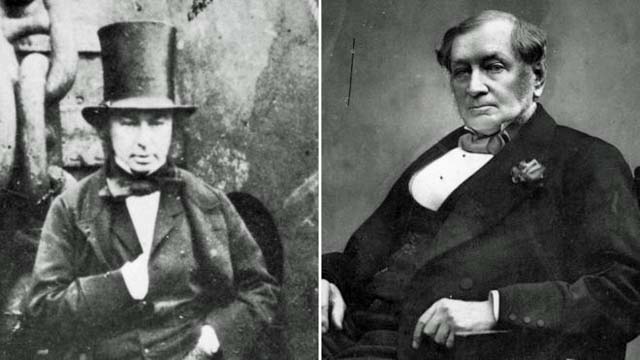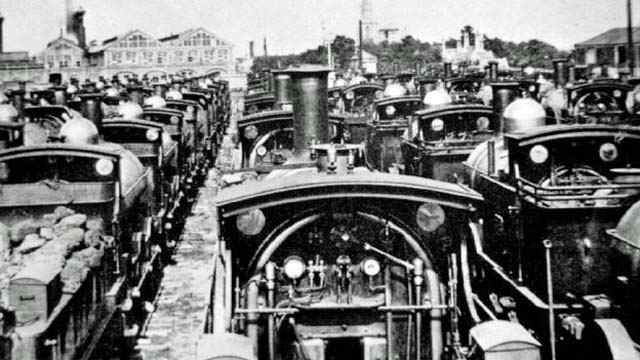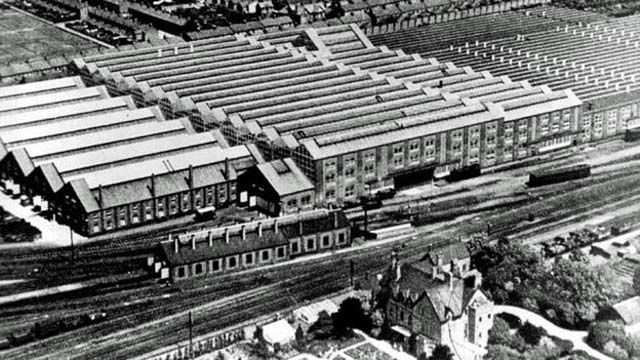
to Become a Boomtown?
Swindon was a small agricultural holding before the arrival of Victorian engineer Isambard Kingdom Brunel and his railway.
But does the town owe its existence to the trajectory of a discarded ham sandwich?
The Wiltshire town is marking the 175th anniversary of the decision to open a railway works, the catalyst that transformed it into a bustling industrial centre.
But according to legend, the decision to build the works was inspired by a half-finished lunch.
Brunel's Great Western Railway (GWR) needed a central repair works at the halfway point between London and Bristol.
"He and his superintendent Daniel Gooch were driving along looking for this space to build the locomotive repair works," said GWR historian Felicity Jones.
"They knew they needed somewhere along the London to Bristol line, but couldn't make a decision.
"So, eating their lunch while they were on the move, Brunel apparently stood up with half a ham sandwich in his hand threw it out of the carriage and said, Wherever this sandwich lands we'll build our locomotive repair facility, and it landed at Swindon."
The origins of the story are lost and there appears no way to confirm, or disprove, its accuracy.
Felicity said there were "sound reasons" for locating the works in Swindon, such as the availability of land and steep gradients that meant that locomotives on the Swindon to London line had to stop to load up on coal and water.
But whether or not a half-finished lunch was involved, Brunel's decision resulted in a remarkable transformation.

Swindon was surrounded by open farmland at the time and was home to a population of just 2,500.
Within years of the railway works opening, it was employing more than 40,000 workers.
Authorization for the works was given on 25 Feb 1841.
Construction began almost immediately and the 300 acre site became operational on 2 Jan 1843.
Brunel also built a village of terraced stone houses near the works to accommodate his influx of workers.
The Railway Village still stands today as a legacy of the great engineer's impact on the town.
Swindon Heritage magazine's Graham Carter said, "Old Swindon, which is the area we now call Old Town, existed for centuries as an insignificant market town. But when GWR arrived in 1841, and began building the Railway Village below the hill, they were literally creating a new town. This quickly became known as New Swindon. Most of its inhabitants were skilled men who were "imported" to work in the railway maintenance and servicing facility created by Gooch and Brunel. The two Swindons were largely independent of each other until amalgamation in 1900. By then a sleepy Wiltshire rural community had transformed into a major industrial centre."
Brunel's GWR Works transformed Swindon from a tiny hilltop settlement with a population of just 2,500 to a leading centre of industry.
Graham said, "The population of New Swindon grew from zero in 1841 to around 2,500 in 1851, thus equalling Old Swindon in just 10 years. By the time Old Town and New Swindon amalgamated as a new borough in 1900, the population was around 45,000, although Old Town had barely changed during this time. Swindon has been growing almost non-stop since 1841."

Railway Town - How Swindon Developed
- Swindon began as a Saxon village and is mentioned in the Domesday Book;
- Its name is derived from the Saxon words "swine dun" meaning pig hill, or the hill where pigs were bred;
- The Wiltshire and Berkshire canal which ran through the town was built in 1810;
- Brunel's GWR Works officially opened in January 1843 with 180 workers;
- By the early 20th Century it was employing more than 75 percent of the town's entire workforce.
The site thrived for more than 140 years as the national hub of engine building in the UK.
As well as providing a world-class repair facility, it was also responsible for the construction of much-loved steam locomotives such as "The Evening Star" and the "King George V".
The works finally closed in 1986, shortly after the announcement that 1,500 jobs at British Rail Engineering Ltd. would be cut.
The First Great Western train operator re-branded itself as Great Western Railway (GWR) in September.
GWR's Paul Gentleman said the original company's legacy to Swindon is "the growth of the railway since 1841 as it sits in the heart of our network on the main line serving London, Bristol, and south Wales".
The land occupied by GWR has long since been redeveloped, with the former workshops and buildings transformed into the McArthur Glen Designer Outlet Village, Botellino's Italian Restaurant, and the STEAM Museum.
The town now boasts a population of more than 200,000 and is home to major companies such as Intel, WHSmith PLC, and Honda.
Daniel Garrett.
of the Canadian Copyright Modernization Act.




